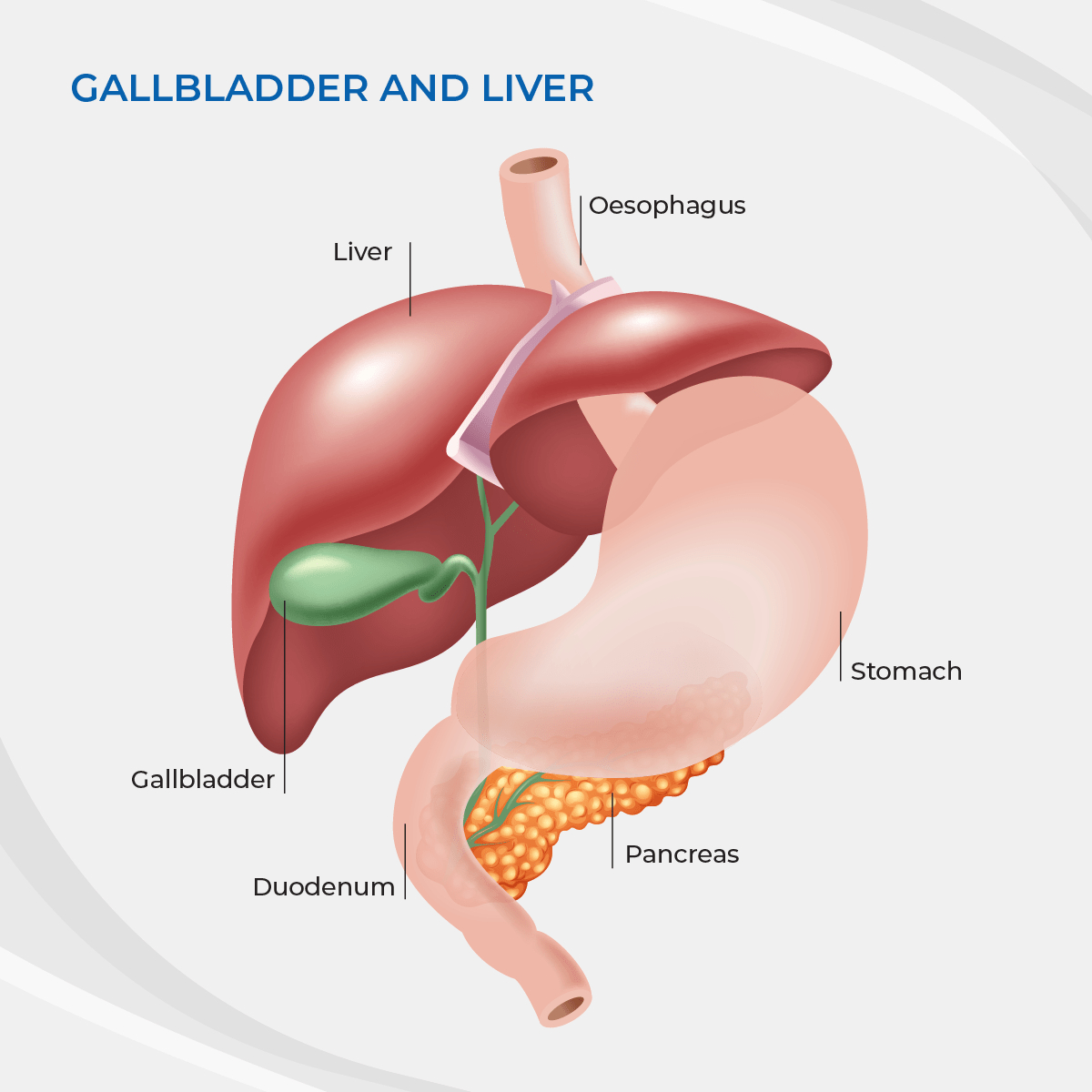What is the gallbladder?
The gallbladder is an organ located under your rib cage and your liver on the right-hand side of your belly. The liver produces bile, which drains down a tube called the bile duct to mix with food and aid the digestion of fats. The gallbladder acts as a temporary reservoir for about 10% of bile. It can release stored bile during a meal to aid digestion. It is connected by a short tube called the cystic duct into the bile duct.
Gallstones
Gallstones can form in the gallbladder and occur in 10 to 20% of people over their lifetime. A lot of gallstones don’t cause any problems and these can be safely left alone. The main reasons for having your gallbladder removed is because it is causing you pain (often called biliary colic) or because your gallstones have caused serious illness such as infection of the bile duct (cholangitis) or inflammation of the pancreas (pancreatitis). Occasionally it may be recommended that your gallbladder is removed because you have polyps in your gallbladder which are in danger of turning into cancer.

Laparoscopic cholecystectomy (keyhole surgery to remove the gallbladder)
The gallbladder can be removed safely and easily using keyhole surgery. To do so requires detaching the gallbladder from the bile duct and removing it from the undersurface of the liver. This is accomplished using keyhole surgery requiring 4 to 5 small incisions on your belly wall. A cholangiogram (x-ray test of the bile duct) may be performed during the operation to determine whether any of your gallstones have fallen out of the gallbladder and into the bile duct.
Gallbladder surgery is one of the most common keyhole operations performed and is done either as day surgery or requiring an admission overnight.
Before your operation
Keeping to a diet low in fatty foods can decrease the amount of pain you get from your gallstones. It is not necessary to continue this diet after your operation. If you have a fatty liver Dr Hamer may recommend a special diet to shrink your liver before your operation to make it safer.
The day of your operation
On the day of your operation you will be admitted to the hospital. You will meet your anaesthetist and have a chance to ask any questions about your anaesthetic. After your operation you will wake in the recovery area before being moved to the day care unit or the ward. If you are feeling well enough and the medical staff are happy that it is safe for you to do so, you may be able to go home the same day as your operation. Otherwise you will be admitted overnight in hospital and discharged the following day.
Recovery
For the 24 hours after your operation you may still be under the effects of the anaesthetic even if you do not feel so. You need to be in the company of a responsible adult, refrain from drinking alcohol, not do any work or make any important decisions. You should not do any hazardous activities such as climbing ladders.
Pain relief
Paracetamol is the safest and best form of pain relief after keyhole surgery. It has no side effects and can be taken safely on a regular basis when taken according to the instructions on the packet. You may need some stronger pain relief in the first 2 to 3 days after your operation, but these can often have side effects such as drowsiness, nausea and constipation and the best kept to a minimum.
Driving
No driving is allowed for 24 hours after your anaesthetic. You should not drive whilst still taking any pain killers stronger than paracetamol. You can resume driving when you are safe to perform an emergency stop. This means you need to be able to stamp on the ground without any pain or flinching (so you can brake in an emergency without hesitating). This is often about 5-7 days after your surgery.
Other things you need to know
Even though laparoscopic cholecystectomy is performed as a day procedure it is still classed as major surgery and carries associated risks. Any operation carries small risks related to the anaesthetic, and the stress of the operation on your heart and your lungs. During any operation there are small risks of bleeding, infection and small hernias developing where the keyhole incisions are made. You must also be aware that your surgeon is operating in your belly near other organs such as your bowel. Specific to having your gallbladder removed there is a small risk of your bile duct being injured. Although this is less than one in 350 it can require major surgery subsequent to your first operation. Occasionally bile leakage can occur from the liver or cystic duct after cholecystectomy and this can require further keyhole surgery or telescope tests such as ERCP to stop the leakage. If this occurs it can delay your recovery by 3-4 days.
Overall, gallbladder surgery is safe and effective with a very low complication rate. If you have any questions you should ask Dr Hamer before proceeding.
Bile duct stones
If you have stones in your bile duct these may need to be removed. Sometimes before your operation these have been found on your ultrasound or by an MRI scan. Sometimes they are discovered at the time of operation during a cholangiogram (xray test done as part of your operation). Depending on the size and the location of the stones in the bile duct, they may be removed during the same operation to remove your gallbladder (bile duct exploration) or require a subsequent procedure called an ERCP to remove them.
